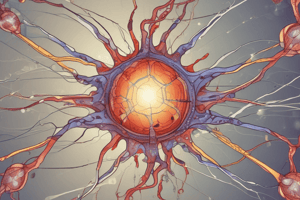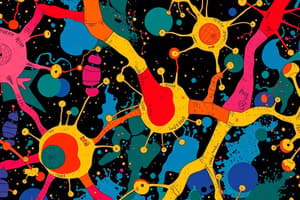Podcast
Questions and Answers
Which of the following signaling pathways is activated by the α1 receptor?
Which of the following signaling pathways is activated by the α1 receptor?
- Activation of phospholipase C (PLC) leading to increased DAG and IP3. (correct)
- Activation of adenylyl cyclase leading to increased cAMP.
- Inhibition of adenylyl cyclase leading to decreased cAMP.
- Direct activation of Rho kinase.
What is the primary effect of stimulating β2 receptors in bronchial smooth muscle?
What is the primary effect of stimulating β2 receptors in bronchial smooth muscle?
- Bronchodilation (correct)
- Bronchoconstriction
- Increased mucus production
- Decreased pulmonary blood flow
Which of the following is a downstream effect of M2 receptor activation in the heart?
Which of the following is a downstream effect of M2 receptor activation in the heart?
- Increased calcium influx
- Decreased cAMP and inhibition of MLCK (correct)
- Increased heart rate and contractility
- Activation of adenylyl cyclase
Which G-protein class is associated with the α2 receptor?
Which G-protein class is associated with the α2 receptor?
What is the effect of α1 receptor activation on vascular smooth muscle?
What is the effect of α1 receptor activation on vascular smooth muscle?
Which second messenger is directly increased as a result of β1 receptor stimulation in the heart?
Which second messenger is directly increased as a result of β1 receptor stimulation in the heart?
What is the result of activating Rho kinase in smooth muscle?
What is the result of activating Rho kinase in smooth muscle?
Which receptor, when stimulated, leads to a decrease in sympathetic outflow from presynaptic nerve terminals?
Which receptor, when stimulated, leads to a decrease in sympathetic outflow from presynaptic nerve terminals?
What is the direct effect of stimulating the M3 receptor on bronchial smooth muscle?
What is the direct effect of stimulating the M3 receptor on bronchial smooth muscle?
Which of the following receptors, when activated, primarily increases heart rate and contractility?
Which of the following receptors, when activated, primarily increases heart rate and contractility?
Activation of which receptor leads to increased renin release from the kidney?
Activation of which receptor leads to increased renin release from the kidney?
Which second messenger system is utilized by the M3 receptor to exert its effects?
Which second messenger system is utilized by the M3 receptor to exert its effects?
What effect does the activation of the α2 receptor have on cAMP levels inside the cell?
What effect does the activation of the α2 receptor have on cAMP levels inside the cell?
In smooth muscle, increased intracellular calcium, resulting from IP3 stimulation, directly leads to:
In smooth muscle, increased intracellular calcium, resulting from IP3 stimulation, directly leads to:
Which neurotransmitter primarily activates the M2 receptor?
Which neurotransmitter primarily activates the M2 receptor?
Which of these events is a direct consequence of activating the Gq protein-coupled receptor?
Which of these events is a direct consequence of activating the Gq protein-coupled receptor?
Based on the information, what effect would an agonist of the β2 receptor have on blood vessels in skeletal muscle?
Based on the information, what effect would an agonist of the β2 receptor have on blood vessels in skeletal muscle?
Which intracellular change would you expect to see after administering a drug that selectively activates M2 receptors?
Which intracellular change would you expect to see after administering a drug that selectively activates M2 receptors?
How does activation of the α1 receptor lead to smooth muscle contraction?
How does activation of the α1 receptor lead to smooth muscle contraction?
Which statement accurately describes the role of Myosin Light Chain Phosphatase (MLCP)?
Which statement accurately describes the role of Myosin Light Chain Phosphatase (MLCP)?
Flashcards
α1 Receptor
α1 Receptor
Receptor: α1; Neurotransmitter: NE; Tissue: VSM; G-protein class: q; Second messenger: Activates PLC, converts PIP2 to DAG + IP3
α2 Receptor
α2 Receptor
Receptor: α2; Neurotransmitter: NE; Tissue: Presynaptic nerve terminal; G-protein class: i; Second messenger: Inhibits adenylyl cyclase, decreases cAMP
β1 Receptor
β1 Receptor
Receptor: β1; Neurotransmitter: NE/Epi; Tissue: Heart, Kidney; G-protein class: s; Second messenger: Activates adenylyl cyclase, converts ATP to cAMP
β2 Receptor
β2 Receptor
Signup and view all the flashcards
M2 Receptor
M2 Receptor
Signup and view all the flashcards
M3 Receptor
M3 Receptor
Signup and view all the flashcards
How Alpha-2 affects cAMP?
How Alpha-2 affects cAMP?
Signup and view all the flashcards
How Alpha-1 affects PLC?
How Alpha-1 affects PLC?
Signup and view all the flashcards
Beta-1's Second Messenger
Beta-1's Second Messenger
Signup and view all the flashcards
Beta-2's Effect on Adenylyl Cyclase
Beta-2's Effect on Adenylyl Cyclase
Signup and view all the flashcards
M2's Effect on cAMP
M2's Effect on cAMP
Signup and view all the flashcards
M3's Second Messenger Pathway
M3's Second Messenger Pathway
Signup and view all the flashcards
Study Notes
- This table summarizes receptor activation/inhibition; consult topic notes for comprehensive details.
Receptor Types and Effects
α1 Receptor
- Responds to Norepinephrine (NE)
- Found in Vascular Smooth Muscle (VSM) and visceral smooth muscle.
- G-protein class is q.
- Activates PLC, converting PIP2 into DAG + IP3, leading to VSM contraction and vasoconstriction.
- DAG stimulates PKC.
- IP3 increases Ca release, forms Ca/Calmodulin complex, stimulates MLCK, leading to Myosin-P+actin contraction.
- Activates Rho kinase, which inhibits MLCP.
- Results in muscle contraction.
α2 Receptor
- Responds to NE.
- Located in presynaptic nerve terminals.
- G-protein class is i.
- Inhibits adenylyl cyclase, decreasing ATP to cAMP conversion, leading to reduced cAMP stimulation of PKA and decreased Ca.
- Causes a decrease in sympathetic (adrenergic) outflow.
β1 Receptor
- Responds to NE/Epi.
- Found in the heart and kidney.
- G-protein class is s.
- Activates adenylyl cyclase, converting ATP to cAMP.
- Increases heart rate (HR), contractility, and renin release.
- cAMP stimulates PKA, increasing Ca release.
β2 Receptor
- Responds to Epi.
- Located in VSM and bronchial smooth muscle.
- G-protein class is s.
- Activates adenylyl cyclase, converting ATP to cAMP, resulting in vasodilation and bronchodilation.
- cAMP stimulates PKA, which then increases Ca release.
M2 Receptor
- Responds to Acetylcholine (Ach).
- Found in the heart.
- G-protein class is i.
- Inhibits adenylyl cyclase, decreasing ATP to cAMP conversion.
- Decreases HR and contractility.
- Decreased cAMP stimulation of PKA leads to reduced Ca influx/release.
M3 Receptor
- Responds to Ach.
- Located in bronchial smooth muscle and endothelial cells.
- G-protein class is q.
- PLC converts PIP2 into DAG + IP3, leading to bronchodilation and vasodilation.
- DAG stimulates PKC.
- IP3 stimulates Ca release.
Studying That Suits You
Use AI to generate personalized quizzes and flashcards to suit your learning preferences.




